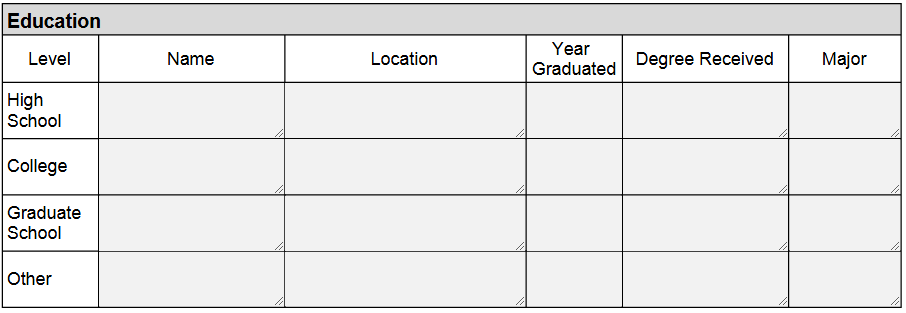Fillable Form Job Application Template
Form or paper which indicates interest in a particular place of employment or position within a company. Typically requests personal identification information, such as name, address and phone number, as well as a history of job experience.
Fill and sign Job Application Template online and download in PDF.
What is a Job Application Form?

A Job Application Form, or also known as an Employment Application Form, is a document that companies, entities, or businesses use as a means to discover and look for new employees.
This form allows employers to see if the applicant is fit for a position in their respective companies
What info do I need for a job application?
A typical job application form includes the following information:
- Personal Information
- Background
- Position
- Education
- Character references
- Employment history
What other documents do I need for a job application?
Aside from your job application form, you will also need the following:
- Cover Letter: A one-pager that introduces you to the employer.
- Resume: A summary of your work experience, education, and skills.
- Letter of Recommendation: A written endorsement from someone who can vouch for your qualifications, work ethic, or character.
How to fill out a Job Application Form?
Get a copy of Job Application Template template in PDF format.
First, get a job application form template from PDFRun.
Then, provide the following information:
Section 1: Personal Information

This section contains your personal information.
- Name
Enter your last name, first name, and middle name.
- Address
Enter your residence address.
- City
Enter your city.
- State
Enter your state.
- ZIP Code
Enter your ZIP code.
- Telephone Number
Enter your telephone number.
- Mobile Number
Enter your mobile number.
- Email Address
Enter your email address.
Section 2: Background

This section contains your work, army, and criminal background.
- Question 1
Mark YES if you are legally eligible to work in the United States; otherwise, mark NO.
- Question 2
Mark YES if you are a Veteran; otherwise, mark NO.
- Branch of Service
Enter your branch of service when you were still in the military.
- Date of Entry
Enter the date when you joined the military.
- Date of Discharged
Enter the date when you were discharged from the military.
- Question 3
Mark YES if you have ever been convicted of a crime; otherwise, mark NO. If you marked YES, specify the crime you have been convicted of.
- Citation
Enter the crime you have been convicted of.
- Date
Enter the date when you have committed the crime.
- Cit
Enter the city where you have committed the crime.
- State
Enter the state where you have committed the crime.
Section 3: Position

This section contains the basic details about the position you are applying for.
- Position Applying
Enter the position you are applying for in this company.
- Start Date
Enter the date when you would like to start working.
- Desired Salary
Enter the amount of the salary you wish to receive.
- Employment Type Desire
Mark the appropriate box which corresponds to the type of employment you would like to have. You may select:
- Full time
- Part time
- Seasonal or temporary
Section 4: Education

This section contains your education history. Enter the following information for your High School, College, Graduate School, or any other education institution you went to.
- Name
Enter the name of the educational institution you went to.
- Location
Enter the location of the educational institution.
- Year Graduated
Enter the year you have graduated from the educational institution.
- Degree Received
Enter the degree you have received in the educational institution.
- Major
Enter the major you took in the educational institution..
Section 5: Character References

This section contains your character references. Enter the following information for each character reference:
- Name of Reference
Enter the full legal name of your first reference.
- Title
Enter the job title of your first reference.
- Company
Enter the company name of your first reference.
- Contact Number
Enter the contact number of your first reference.
Section 6: Employment History

List your four most recent jobs. Enter the following information for each job:
- Employer
Enter the full legal name of your employer in your previous company.
- Position
Enter the position you had in your previous company.
- From
Enter the date when you started working for your previous company.
- To
Enter the date when you stopped working for your previous company.
- Supervisor
Enter the full legal name of your supervisor in your previous company.
- Contact Number
Enter the contact number of your supervisor in your previous company.
- Starting Salary
Enter the amount of your starting salary in your previous company.
- Ending Salary
Enter the amount of your ending salary in your previous company.
- Address
Enter the address of your previous company.
- Reason for Leaving
Enter the reason why you left your previous company.
- Contact Employer
Mark YES if you are comfortable with the company you are currently applying for to contact your previous employer; otherwise, mark NO.
Section 7: Acknowledgement & Authorization

By signing this Job Application Form, you hereby certify that all of your answers and all of the information you entered are true and complete to the best of your knowledge. If this Job Application Form results in your employment, you must understand that any false or misleading information in your application will be considered a sufficient cause for dismissal.
- Applicant Name
Enter your full legal name.
- Applicant Signature
Affix your signature.
- Current Date
Enter the current date
Start filling out a Job Application Template sample and export in PDF.
Frequently Asked Questions About a Job Application Form
What are the types of job applications?
There are many different types of job applications, depending on the type of position and company.
Here are the types of job applications:
- Paper applications, which you submit in person or by mail.
- Online applications, which you complete and submit electronically through an employer's website or job board.
- Video submissions, which allow you to record a short video showcasing your skills or qualifications for the position.
- Skills assessments, which may test your proficiency in certain areas like data analysis or writing code.
- Personality tests, which measure traits like agreeableness or neuroticism.
What forms will I encounter when applying for a job?
There are different types of job application forms you might use or encounter, including:
- Cover letter: Introduces your resume and explains why you're a good fit.
- Letter of interest: Shows interest in future opportunities, even if no job is listed.
- Thank-you note: Sent after interviews to show appreciation and reinforce interest.
- Informational interview request: Asks a professional for career advice.
- Application letter: A formal letter expressing interest in a specific job.
- Reference or recommendation letter: Written by someone who can vouch for you.
- Rejection letter: Sent by employers to inform candidates they weren’t selected.
What is the job application process?
The job application process can vary depending on the type of position you are applying for, as well as the employer.
In general, the process typically involves the following steps:
- Research the company and job.
- Tailor your resume and cover letter.
- Submit your application (online, by email, or in person).
- Go through one or more interviews.
- Follow up to thank the interviewer and express interest.
- Receive and accept (or decline) the job offer.
Pro tip: Customizing your application for each job boosts your chances.
Is an application letter the same as a CV?
No. A CV details your full work and education history. An application letter is a short, personalized message explaining why you’re applying.
What are the most important things to remember when completing a job application form?
Keep these tips in mind when filling out your job application:
- Fill everything out: Missing info looks careless.
- Be truthful: Don’t exaggerate your experience.
- Take your time: Rushed answers can lead to mistakes.
A clean, complete application helps you stand out for the right reasons.
Create a Job Application Template document, e-sign, and download as PDF.
Related Articles:
- Job Applications: Types, Forms, and Samples
- Write a successful job application
- How To Write an Application Letter
Keywords: job application form form job application employment application fillable job application form online form job application employment application pdf job application template job application printable job application pdf
















